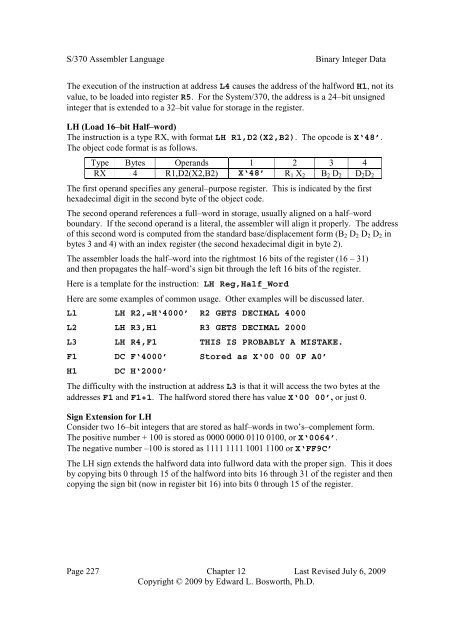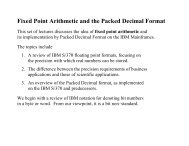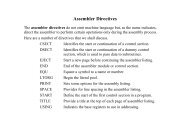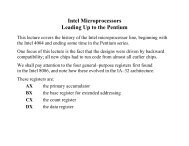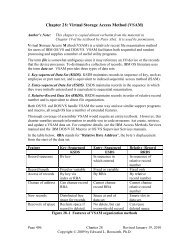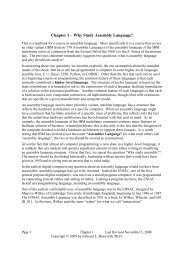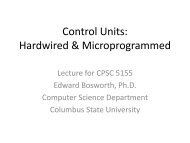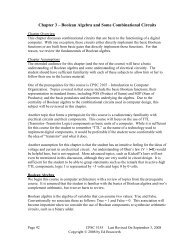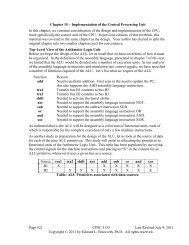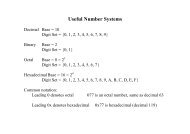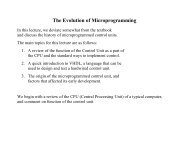PDF Version - Edwardbosworth.com
PDF Version - Edwardbosworth.com
PDF Version - Edwardbosworth.com
You also want an ePaper? Increase the reach of your titles
YUMPU automatically turns print PDFs into web optimized ePapers that Google loves.
S/370 Assembler Language Binary Integer Data<br />
The execution of the instruction at addressL4 causes the address of the halfwordH1, not its<br />
value, to be loaded into registerR5. For the System/370, the address is a 24–bit unsigned<br />
integer that is extended to a 32–bit value for storage in the register.<br />
LH (Load 16–bit Half–word)<br />
The instruction is a type RX, with formatLH R1,D2(X2,B2). The opcode isX‘48’.<br />
The object code format is as follows.<br />
Type Bytes Operands 1 2 3 4<br />
RX 4 R1,D2(X2,B2) X‘48’ R 1 X 2 B 2 D 2 D 2 D 2<br />
The first operand specifies any general–purpose register. This is indicated by the first<br />
hexadecimal digit in the second byte of the object code.<br />
The second operand references a full–word in storage, usually aligned on a half–word<br />
boundary. If the second operand is a literal, the assembler will align it properly. The address<br />
of this second word is <strong>com</strong>puted from the standard base/displacement form (B 2 D 2 D 2 D 2 in<br />
bytes 3 and 4) with an index register (the second hexadecimal digit in byte 2).<br />
The assembler loads the half–word into the rightmost 16 bits of the register (16 – 31)<br />
and then propagates the half–word’s sign bit through the left 16 bits of the register.<br />
Here is a template for the instruction: LH Reg,Half_Word<br />
Here are some examples of <strong>com</strong>mon usage. Other examples will be discussed later.<br />
L1 LH R2,=H‘4000’ R2 GETS DECIMAL 4000<br />
L2 LH R3,H1 R3 GETS DECIMAL 2000<br />
L3 LH R4,F1 THIS IS PROBABLY A MISTAKE.<br />
F1 DC F‘4000’ Stored as X‘00 00 0F A0’<br />
H1<br />
DC H‘2000’<br />
The difficulty with the instruction at addressL3 is that it will access the two bytes at the<br />
addressesF1 andF1+1. The halfword stored there has valueX‘00 00’, or just 0.<br />
Sign Extension for LH<br />
Consider two 16–bit integers that are stored as half–words in two’s–<strong>com</strong>plement form.<br />
The positive number + 100 is stored as 0000 0000 0110 0100, orX‘0064’.<br />
The negative number –100 is stored as 1111 1111 1001 1100 orX‘FF9C’<br />
The LH sign extends the halfword data into fullword data with the proper sign. This it does<br />
by copying bits 0 through 15 of the halfword into bits 16 through 31 of the register and then<br />
copying the sign bit (now in register bit 16) into bits 0 through 15 of the register.<br />
Page 227 Chapter 12 Last Revised July 6, 2009<br />
Copyright © 2009 by Edward L. Bosworth, Ph.D.


